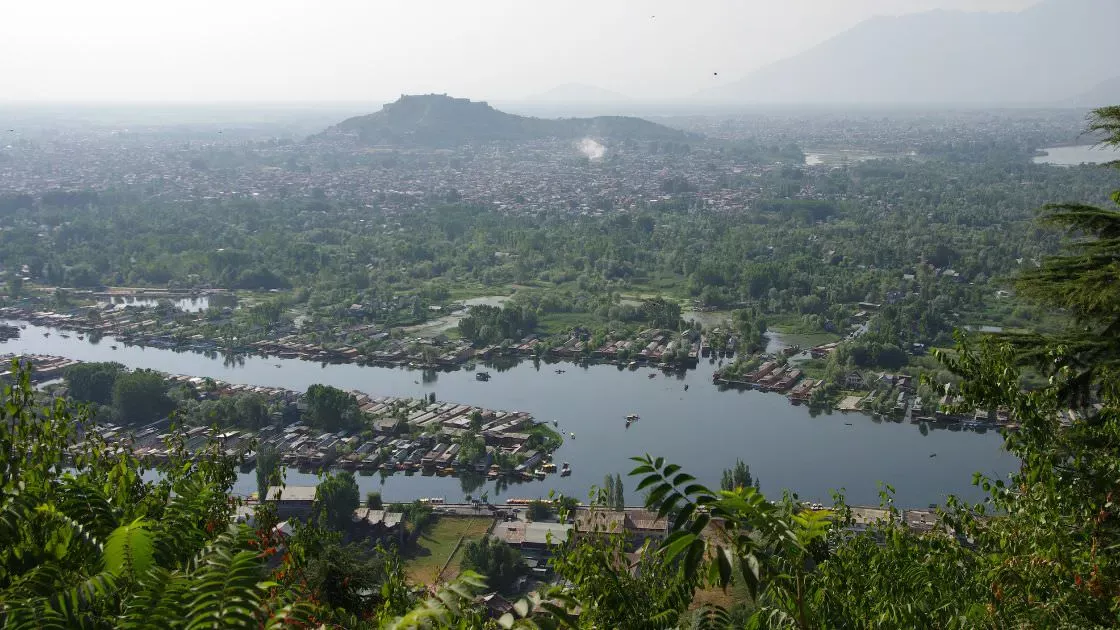Srinagar is the summer capital (May to October) of the Indian Occupied State of Jammu and Kashmir. It is situated in the Kashmir Valley and lies on the banks of the Jhelum River, a tributary of the Indus. The city is famous for its gardens, lakes, and houseboats. It is also known for traditional Kashmiri handicrafts and dry fruits.
Origin of Names
Etymologically, Srinagar is composed of two Sanskrit words, Sri (Lakshmi) and nagar, which means ‘city.’ One theory about the origin of the name is that Pandava King Ashok (not to be confused with the Mauryan Emperor Ashok) built the city of Srinagari (Srinagar). Another theory is that Mauryan Emperor Ashoka founded the original city of Srinagar, then situated on the site of the present village of Pandrethan, 5 km to the north of the existing capital.
History
Ancient Srinagar
Srinagar has a long history, dating back to at least the 3rd century BC, and has been known by different names. The city is said to have been founded by King Pravarasena II over 2,000 years ago, named it Parvasenpur. The city was then a part of the Maurya Empire, one of the largest empires of the Indian subcontinent. Ashoka introduced Buddhism to the Kashmir Valley, and the adjoining regions around the city became a center of Buddhism. In the 1st century, the region was under the control of the Kushans, based out of modern Pakistan and Afghanistan. Several rulers of this dynasty strengthened the Buddhist traditions. Vikramaditya (of Ujjain) and his successors probably ruled the regions just before the city fell to the control of the Huns, a nomadic tribe from central Asia, in the 6th century. Mihirkula was the most dreaded ruler of the city and the valley.
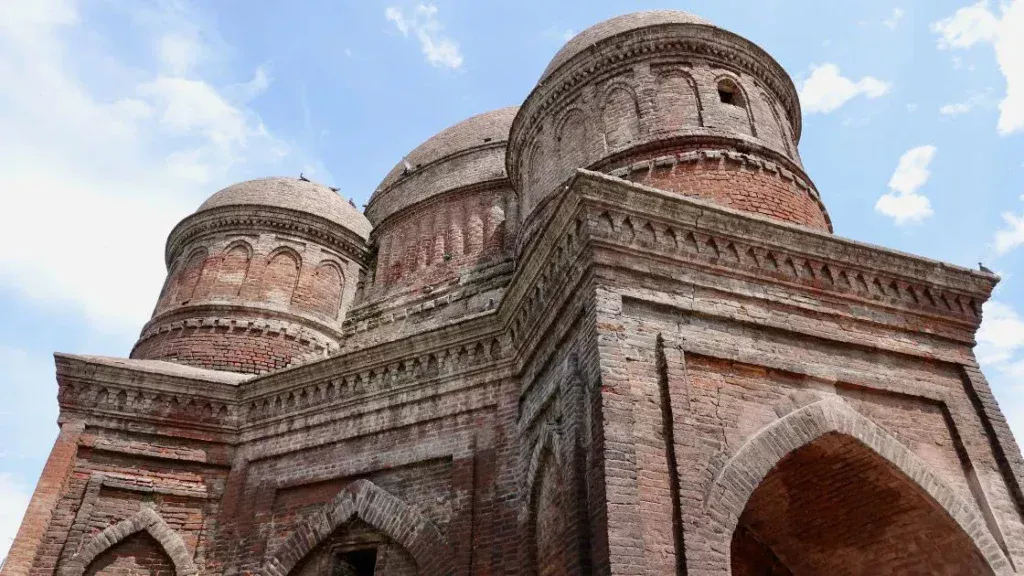
Srinagar in 14th to 19th Centuries
The independent Hindu and Buddhist rule over Srinagar lasted until the 14th century when the Kashmir valley, including the city, came under the control of several Muslim rulers, including the Mughals. It was also the capital during the reign of Yusuf Shah Chak, an independent Kashmiri ruler who was tricked into submission by Akbar when Akbar failed to conquer Kashmir by force. Yusuf Shah Chak remains buried in Bihar in India. Akbar established Mughal rule in Srinagar and the Kashmir Valley.
With the disintegration of the Mughal Empire after the death of Aurangzeb in 1707, infiltrations to the valley from the Pashtun tribes increased, and the Durrani tribes of Afghanistan ruled the city for several decades. Maharaja Ranjit Singh of Punjab province annexed a major part of the Kashmir Valley, including Srinagar, to his kingdom in 1814, and the city came under the influence of the Sikhs. In 1846, the Treaty of Lahore was signed between the Sikh rulers and the British in Lahore. The treaty inter alia provided British de facto suzerainty over the Kashmir Valley and installed Gulab Singh as an independent and sovereign ruler of the region. Srinagar became part of his kingdom and remained so until 1947 as one of several princely states in British India. The Maharajas chose Sher Garhi Palace as their main residence at Srinagar.
Post-Indian Independence
After India and Pakistan’s independence from Britain, villagers around the city of Poonch began an armed protest at the continued rule of the Maharaja on August 17, 1947. In view of the Poonch uprising, certain Pashtun tribes, such as Mehsud and Afridi from the mountainous region of Khyber Pakhtunkhwa in Pakistan and with its collusion, entered the Kashmir Valley to capture it on October 22, 1947. The Maharaja, who had refused to accede to either India or Pakistan in the hope of maintaining his own independent state, signed the instrument of accession with India in exchange for refuge on October 26, 1947, as tribesmen approached the outskirts of Srinagar. The accession was accepted by India the next day. The government of India immediately airlifted Indian troops to Srinagar and prevented the tribesmen from reaching Srinagar. The Indian army has never left since then.
In 1989, Srinagar became the focus of the armed uprising against Indian rule, and continues to be a highly politicized hotbed of separatist activity with frequent spontaneous protests and strikes (“bandhs” in local parlance). With Pakistan Administered Kashmir becoming the base camp of dozens of Islamic militant organizations, hundreds of heavily armed militants waged war against Indian rule, compelling the union government to deploy thousands of troops to deal with the situation. On January 19, 1990, the Gawkadal massacre of at least 50 unarmed protestors by Indian forces, and up to 280 by some estimates from eyewitness accounts, set the stage for bomb blasts, shootouts, and curfews that characterized Srinagar throughout the early and mid-1990s. Further massacres in the spring of 1990 in which 51 unarmed protesters were allegedly killed by Indian security forces in Zakura and Tengpora, along with the January 6th, 1993 massacre of 55 unarmed protestors allegedly by Indian security forces in the nearby town of Sopore, heightened anti-Indian sentiments in Srinagar. As a result, bunkers and checkpoints are found throughout the city, although their numbers have come down in the past few years as militancy has declined. However, frequent protests still occur against Indian rule, such as the August 22, 2008 rally in which hundreds of thousands of Kashmiri civilians protested against Indian rule in Srinagar. Similar protests took place every summer for the next 4 years, and most recently following the execution of Afzal Guru in February 2013. Post-1996 developments, however, include popular elections being regularly held for State assembly with high voter turnout. The violence and street protest frequencies are at an all-time low and the government has been able to maintain effective control over the law and order situation by dealing firmly with terrorists and street protesters brought in as sponsored from across the border.
The city is located on both the sides of the Jhelum River which is called Vyath in Kashmir. The river passes through the City and meanders through the Valley. moving onward and deepening in the Dal Lake. The city is famous for its nine old bridges connecting the two parts of the City.
Hokersar is a wetland situated near Srinagar. Thousands of migratory birds come to Hokersar from Siberia and other regions in the winter season. Migratory birds from Siberia and Central Asia use wetlands in Kashmir as their transitory camps between September and October and again around spring. These wetlands play a vital role in sustaining a large population of wintering, staging, and breeding birds.
Hokersar is 14 km (8.7 mi) north of Srinagar and is a world class wetland spread over 13.75 km² (5.31 sq mi) including lake and marshy area. It is the most accessible and well-known of Kashmir’s wetlands which include Hygam, Shalibug, and Mirgund. A record number of migratory birds have visited Hokersar in recent years.
Birds found in Hokersar include migratory ducks and geese such as the Brahminy Duck, Tufted Duck, Gadwall, Garganey, Greylag Goose, Mallard, Common Merganser, Northern Pintail, Common Pochard, Ferruginous Pochard, Red-crested Pochard, Ruddy Shelduck, Northern Shoveler, Common Teal, and Eurasian Wigeon.
Climate
Srinagar has a humid subtropical climate, with a climate much cooler than what is found in much of the rest of India due to its moderate to high altitude and northerly position. The valley is surrounded by Himalayas on all sides. Winters are cool in the valley, with a January daily mean of 2.5°C (36.5°F), and temperatures remain below freezing at night. Moderate to heavy snowfall is expected in winters and the only road that connects Srinagar with the rest of India frequently gets blocked for a few days due to avalanches. Summers are warm, with a July daily maximum of 30.1°C (86.2°F). The average annual rainfall is around 710 millimeters (28 in). Spring is the wettest season, while autumn is the driest.
• Highest temperature: 38.3°C (100.9°F)
• Lowest: -19.9°C (-3.8°F)
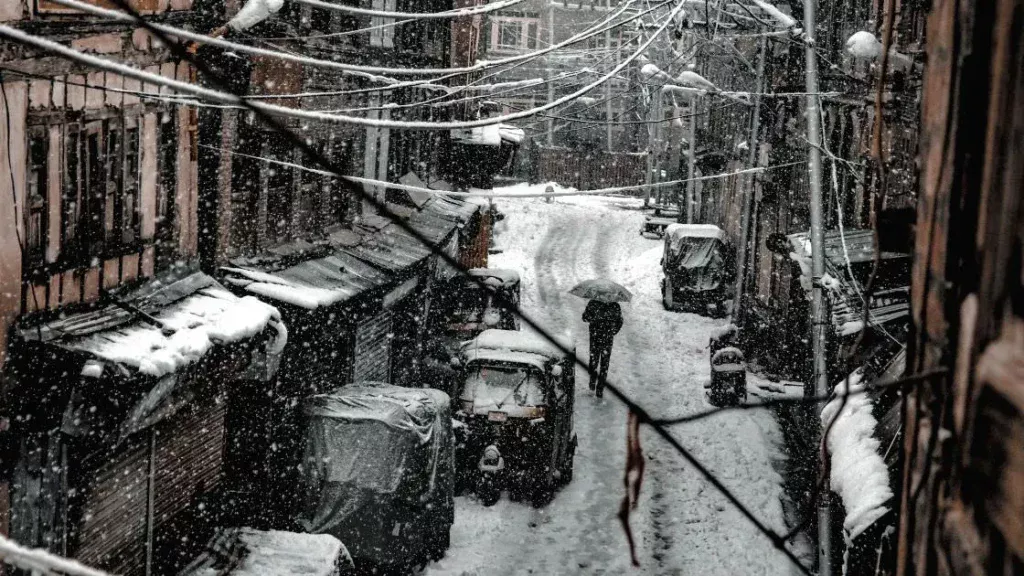
Economy
In November 2011, the City Mayors Foundation – an advocacy think-tank – announced that Srinagar was the 92nd fastest growing urban area in the world in terms of economic growth based on actual data from 2006 onwards and projections to 2020.
Tourism
Srinagar is one of several places that have been called the “Venice of the East” or the “Kashmiri Venice.” Lakes around the city include Dal Lake – noted for its houseboats – and Nagin Lake. Srinagar has some Mughal gardens forming part of those laid by the Mughal emperors across the Indian subcontinent. Those of Srinagar and its close vicinity include Chashma Shahi (the royal fountains), Pari Mahal (the palace of the fairies), Nishat Bagh (the garden of spring), Shalimar Bagh, and the Naseem Bagh. The Sher Garhi Palace houses administrative buildings from the state government. Another palace of the Maharajas, the Gulab Bhavan, has now become the Lalit Grand Palace Hotel.
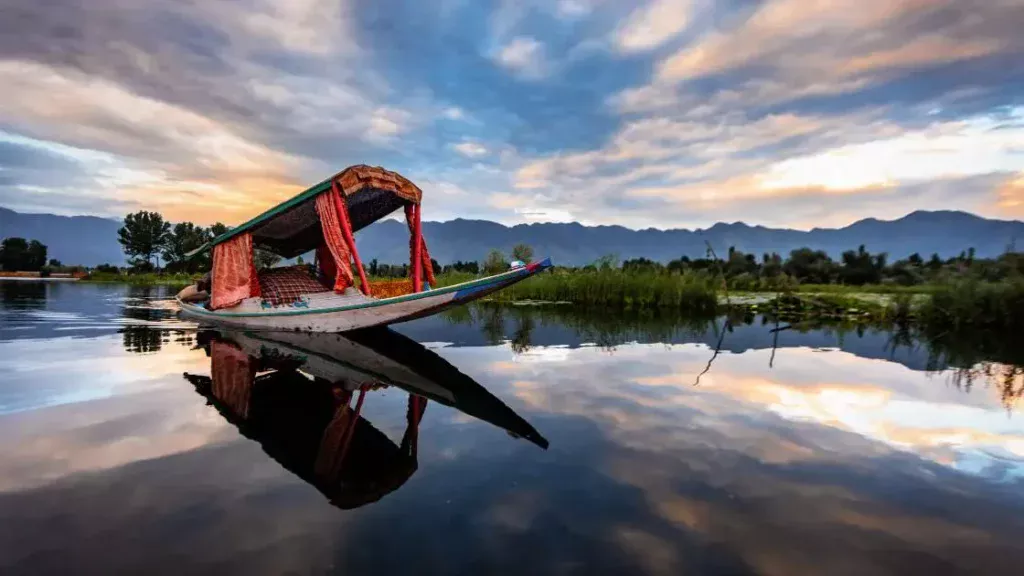
Government and politics
The city is run by the Srinagar Municipal Corporation (SMC). The Srinagar district, along with the adjoining Budgam district, forms the basis of the Srinagar Parliamentary seat.
Stray dog controversy
Srinagar’s city government attracted brief international attention in March 2008 when it announced a mass poisoning program aimed at eliminating the city’s population of stray dogs. Officials estimate that 100,000 stray dogs roam the streets of the city, which has a human population of a little more than 900,000. In a survey conducted by an NGO, it was found that some residents welcomed this program, saying the city was overrun by dogs, while critics contended that more humane methods should be used to deal with the animals. The situation has become alarming with local news reports coming up at frequent intervals highlighting people, especially children, being mauled by street dogs.
Demographics
As of the 2011 census, Srinagar city’s population was 1,192,792, and Srinagar urban agglomeration had 1,273,312 populations. Both the city and the urban agglomeration have an average literacy rate of approximately 71%, while the national average is 74.04%. The child population of both the city and the urban agglomeration is approximately 12% of the total population. Males constitute 53.0%, and females 47.0% of the population. The sex ratio in the city area is 888 females per 1000 males, while in the urban agglomeration it is 880 per 1000, and the nationwide value of this ratio is 940.
Transport Road
The city is served by many highways, including National Highway 1A and National Highway 1D.
Air
Srinagar Airport has regular domestic flights to Leh, Jammu, Chandigarh, and Delhi, as well as occasional international flights. The International flights terminal was inaugurated on February 14, 2009, with an Air India flight from Dubai.
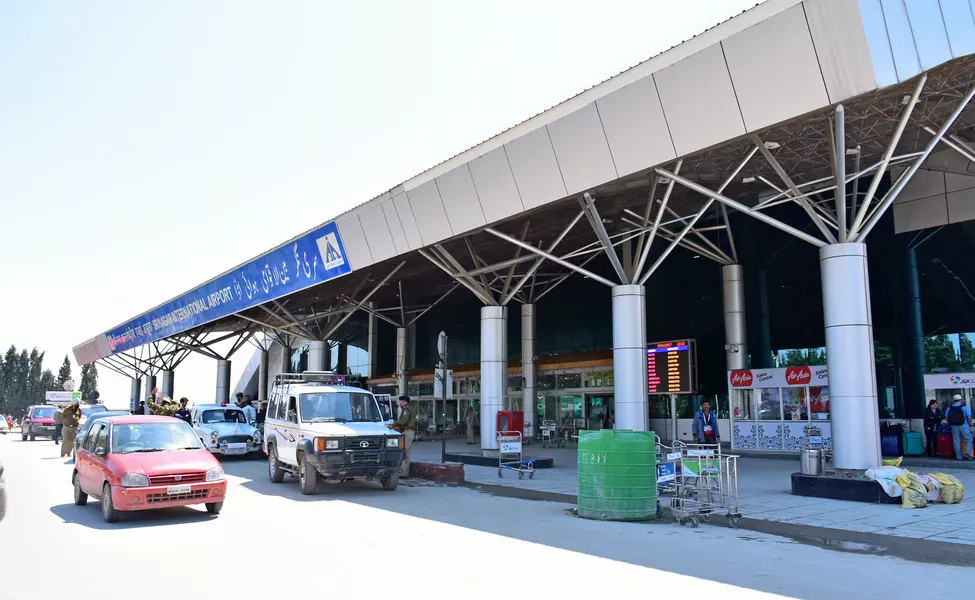
Rail
Srinagar is a station on the 119 km (74 mi) long Kashmir railway track that started in October 2009 and connects Baramulla to Srinagar, Anantnag, and Qazigund. The railway track was to connect Banihal across the Pir Panjal mountains through a newly constructed km long Banihal tunnel by 2012, and subsequently to the Indian railway network after a few years. As of spring 2013, the rail tunnel has not yet been opened, and progress remains slow due to lack of funding. The railway system, proposed in 2001, is not expected to connect the Indian railway network until 2017 at the earliest, with a cost overrun of 5,500 crore rupees.
Culture
Like the state of Jammu and Kashmir, Srinagar also has a distinctive blend of cultural heritage. Holy places in and around the city depict the historical, cultural, and religious diversity of the city as well as the Kashmir Valley.
Places of worship
There are many religious holy places in Srinagar. They include:
- Hazratbal Shrine, (only domed mosque in the city).
- Jama Masjid, Srinagar, (one of the oldest mosques in Kashmir)
- Hamza Makhdum on “Hari Parbhat”
- Kheer Bhawani in Ganderbal
- Hari Parbat Hill hosts shrine of Sharika Mata Temple
- Shankaracharya temple or Takht-e-Sulaiman

Additional structures include the Dastgeer Sahib shrine, Hazratbal Shrine, Mazar-e-Shura, Roza Bal shrine, Khanqah of Shah Hamadan, Patthar Masjid (The Stone Mosque), tomb of the mother of Zain-ul-Abidin, Tomb of Pir Haji Muhammad, Akhun Mulla Shah Mosque, cemetery of Baha-ud-din Sahib, Tomb and Madn Sahib Mosque at Zadiba.
